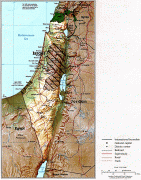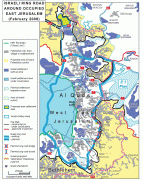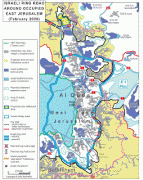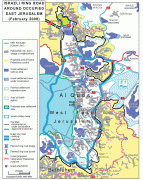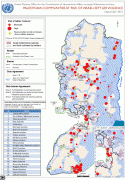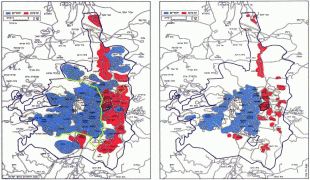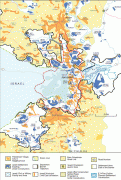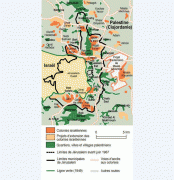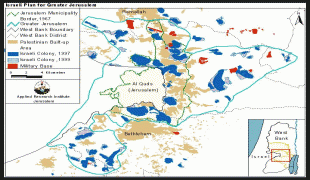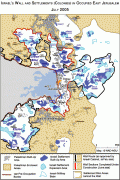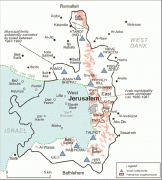East Jerusalem (East Jerusalem)
East Jerusalem (القدس الشرقية, al-Quds ash-Sharqiya; מִזְרַח יְרוּשָׁלַיִם, Mizraḥ Yerushalayim) is the sector of Jerusalem that was held by Jordan during the 1948 Arab–Israeli War, as opposed to the western sector of the city, West Jerusalem, which was held by Israel. Under international law, East Jerusalem is considered a part of the West Bank and, therefore, of the Palestinian territories. A number of states currently recognize East Jerusalem as the capital of the State of Palestine (such as Argentina, Brazil, China, Russia, and all 57 members of the Organisation of Islamic Cooperation), whereas other states (such as Australia, Finland, France, and others) assert that East Jerusalem "will be the capital of Palestine", while referring to East Jerusalem at present as "an occupied territory".
In 2022, East Jerusalem had a population of 595,000 inhabitants, of which 361,700 (61%) are Palestinian Arabs and 234,000 (39%) are Israeli Jewish settlers. The international community regards Israeli settlements in East Jerusalem illegal under international law.
Jerusalem was envisaged as a separate, international city under the 1947 United Nations partition plan. It was, however, divided by the 1948 war that followed Israel's declaration of independence. As a result of the 1949 Armistice Agreements, the city's western half came under Israeli control, while its eastern half, containing the famed Old City, fell under Jordanian control.
Israel occupied East Jerusalem during the 1967 Six-Day War; since then, the entire city has been under Israeli control. The 1980 Jerusalem Law declared unified Jerusalem the capital of Israel, formalizing the effective annexation of East Jerusalem. Palestinians and many in the international community consider East Jerusalem to be the future capital of the State of Palestine. This includes (out of 193) member countries of the United Nations, among them Argentina, Brazil, China, India, Russia, Sweden, and the 57 members countries of Organisation of Islamic Cooperation. The status of Jerusalem has been described as "one of the most intractable issues in the Israeli–Palestinian conflict", with conflicting claims to sovereignty over the city or parts of it, and access to its holy sites.
Israeli and Palestinian definitions of East Jerusalem differ. Following the 1967 Six-Day War, Jerusalem's municipal boundaries were extended totaling an area three times the size of pre-war West Jerusalem. This includes several nearby West Bank villages to the north, east and south of the Old City that are now considered neighborhoods of the city, as well as eight suburban neighborhoods that were built since then. The international community considers these neighborhoods illegal settlements, but the Israeli government disputes this. The Israeli position is based on the extended municipal boundaries, while the Palestinian position is based on the 1949 Armistice Agreements.
East Jerusalem includes the Old City, which is home to many sites of seminal religious importance for the three major Abrahamic religions—Judaism, Christianity, and Islam, including the Temple Mount / Al-Aqsa Mosque, the Western Wall, the Dome of the Rock and the Church of the Holy Sepulchre. In 2016, the population of East Jerusalem was 542,400, comprising 61% of Jerusalem's population. Of these, 327,700 (60.4%) were Arabs and 214,600 (39.6%) were Jews.
Arab residents of East Jerusalem are increasingly becoming integrated into Israeli society, in terms of education, citizenship, national service and in other aspects. According to Middle East expert David Pollock, in the hypothesis that a final agreement was reached between Israel and the Palestinians with the establishment of a two-state solution, 48% of East Jerusalem Arabs would prefer being citizens of Israel, while 42% of them would prefer the State of Palestine. 9% would prefer Jordanian citizenship.
On 27 June 1967, Israel expanded the municipal boundaries of West Jerusalem so as to include approximately 70 km2 of West Bank territory today referred to as East Jerusalem, which included Jordanian East Jerusalem ( 6 km2 ) and 28 villages and areas of the Bethlehem and Beit Jala municipalities 64 km².
East Jerusalem is the familiar term in English. Arabs largely use the term Arab Jerusalem for this area in official English-language documents, emphasizing the predominance of the Arabic-speaking Palestinian population while Israelis call the area East Jerusalem because of its geographic location in the east of the expanded Jerusalem.
In 2022, East Jerusalem had a population of 595,000 inhabitants, of which 361,700 (61%) are Palestinian Arabs and 234,000 (39%) are Israeli Jewish settlers. The international community regards Israeli settlements in East Jerusalem illegal under international law.
Jerusalem was envisaged as a separate, international city under the 1947 United Nations partition plan. It was, however, divided by the 1948 war that followed Israel's declaration of independence. As a result of the 1949 Armistice Agreements, the city's western half came under Israeli control, while its eastern half, containing the famed Old City, fell under Jordanian control.
Israel occupied East Jerusalem during the 1967 Six-Day War; since then, the entire city has been under Israeli control. The 1980 Jerusalem Law declared unified Jerusalem the capital of Israel, formalizing the effective annexation of East Jerusalem. Palestinians and many in the international community consider East Jerusalem to be the future capital of the State of Palestine. This includes (out of 193) member countries of the United Nations, among them Argentina, Brazil, China, India, Russia, Sweden, and the 57 members countries of Organisation of Islamic Cooperation. The status of Jerusalem has been described as "one of the most intractable issues in the Israeli–Palestinian conflict", with conflicting claims to sovereignty over the city or parts of it, and access to its holy sites.
Israeli and Palestinian definitions of East Jerusalem differ. Following the 1967 Six-Day War, Jerusalem's municipal boundaries were extended totaling an area three times the size of pre-war West Jerusalem. This includes several nearby West Bank villages to the north, east and south of the Old City that are now considered neighborhoods of the city, as well as eight suburban neighborhoods that were built since then. The international community considers these neighborhoods illegal settlements, but the Israeli government disputes this. The Israeli position is based on the extended municipal boundaries, while the Palestinian position is based on the 1949 Armistice Agreements.
East Jerusalem includes the Old City, which is home to many sites of seminal religious importance for the three major Abrahamic religions—Judaism, Christianity, and Islam, including the Temple Mount / Al-Aqsa Mosque, the Western Wall, the Dome of the Rock and the Church of the Holy Sepulchre. In 2016, the population of East Jerusalem was 542,400, comprising 61% of Jerusalem's population. Of these, 327,700 (60.4%) were Arabs and 214,600 (39.6%) were Jews.
Arab residents of East Jerusalem are increasingly becoming integrated into Israeli society, in terms of education, citizenship, national service and in other aspects. According to Middle East expert David Pollock, in the hypothesis that a final agreement was reached between Israel and the Palestinians with the establishment of a two-state solution, 48% of East Jerusalem Arabs would prefer being citizens of Israel, while 42% of them would prefer the State of Palestine. 9% would prefer Jordanian citizenship.
On 27 June 1967, Israel expanded the municipal boundaries of West Jerusalem so as to include approximately 70 km2 of West Bank territory today referred to as East Jerusalem, which included Jordanian East Jerusalem ( 6 km2 ) and 28 villages and areas of the Bethlehem and Beit Jala municipalities 64 km².
East Jerusalem is the familiar term in English. Arabs largely use the term Arab Jerusalem for this area in official English-language documents, emphasizing the predominance of the Arabic-speaking Palestinian population while Israelis call the area East Jerusalem because of its geographic location in the east of the expanded Jerusalem.
Map - East Jerusalem (East Jerusalem)
Map
Country - Palestine
 |
 |
* State of Palestine, a state in Western Asia
Currency / Language
| ISO | Currency | Symbol | Significant figures |
|---|---|---|---|
| ILS | Israeli new shekel | ₪ | 2 |
| ISO | Language |
|---|---|
| AR | Arabic language |






